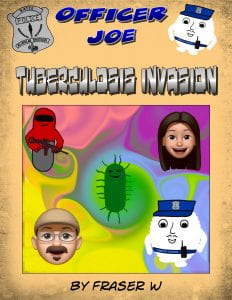
In this project we made comic books about how cells and diseases interact. We kicked off this project by watching the movie Osmosis Jones. I found the animated parts of the movie very entertaining, but the parts with real people were very disgusting for the most part.
How do cells and diseases interact?
Cells and disease interact in many ways, and would be impossible to list them all in this post. However, I think that my comic Officer Joe: Tuberculosis Invasion is a great example of ways cells and diseases interact!
The first Milestone in this project was a Mindmap that displayed questions and previously gained knowledge about cells and diseases. I had previously taken classes on cells, but found that I had forgotten quite a bit. Here is what I was able to remember:
This Milestone was a great way for me to show my ability to accomplish or extend on the competency “Questioning and predicting: Demonstrate a sustained curiosity about a scientific topic or problem of personal interest.” I found that questioning was much easier than displaying previously gained knowledge.
I had a lot of fun with Milestone 2: a wanted poster for a disease. For multiple reasons, I decided on making a wanted poster for tuberculosis. I used Canva to design the wanted poster. I had to some research on how tuberculosis affects other cells, and while doing so discovered that tuberculosis is a very interesting disease indeed! Here is my first draft:
Originally, I forgot to explain what tuberculosis does to cells, which didn’t get me a satisfactory level of accomplishment for the competency “Scientific communication: communicate ideas, findings, and solutions to problems using scientific language, representations, and digital technologies.” So I revised it to include how tuberculosis affects cells. Here is my final version:
After completing Milestone 4 in which we made a storyboard (click here to see mine) to plan out the main events and story line for our comics, I started on Milestone 5: the final comic book.
Milestone 5 took a lot of time and hard work to complete the comic book in time. I used Procreate to make my drawings, and Comic Life 3 to arrange panels and add text. I found it challenging to remember that my illustrations didn’t need to be perfect. I think that I was able to include lots of scientific evidence (and I definitely appreciate it) for the competency “Evaluating: Demonstrate an understanding and appreciation of evidence.” In case you didn’t read my comic at the start of this post, here it is again:

I learned a lot about cellular and disease interaction, comic making and tuberculosis. I hope I will be able to apply all the knowledge I gained in project to future project and learning experiences. This was the last project for PLP 8 this year, and I can’t wait for grade 9 next year. This year has gone by so fast, and I really enjoyed it and learned a ton! Bye for now ✌️



Many people, when they develop a small cough, will go online and find out what it could mean. They then freak out, thinking that they are getting pneumonia, bronchitis, sinusitis, tuberculosis, C.O.P.D, asthma, G.E.R.D, laryngitis, tonsillitis, sinusitis, etc all at the same time when in reality IT’S JUST A COUGH!!! (You can add this to your list of ‘Ways to trigger your doctor’.)
Interesting piece of information…
Amazing blog as always! 🤩 The wanted poster looks very professional as well as the comic! The drawings looked super and it was a very smart and creative idea to use memojis! 🧐 All that hard work really payed off! 🥳
Thanks! The real question is what did you learn from the comic? 🤔
You packed so much information into your comic and still kept it fun to read. I’m Impressed!
Thank you!